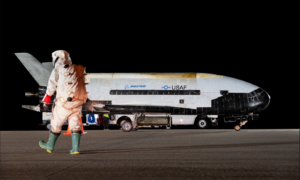Here is SpacePolicyOnline.com’s list of space policy events for the next TWO weeks plus a day and any insight we can offer about them. The House and Senate are in recess except for pro forma sessions.
During the Weeks
The year’s not over yet! We still have one more BIG EVENT in 2023, the X-37B launch on Thursday. That’s all this week, though, so we’re including the first week plus a day of the New Year as the annual round of space-related conferences begins anew.
The X-37B super-secret military spaceplane launch was supposed to happen on December 7, but slipped to December 10, December 11, December 12, December 13, and then a big delay to December 28 due to bad weather or technical reasons. Neither DOD nor SpaceX have been forthcoming about the technical issues, mentioning only the need for “system checkouts.” The X-37B program is a partnership between the Department of the Air Force’s (DAF’s) Rapid Capabilities Office and the Space Force. The Air Force and the Space Force both are part of the DAF.
Designated USSF-52 (U.S. Space Force-52), this is the 7th flight of an Orbital Test Vehicle (OTV) in the X-37B program so is also called OTV-7. There are two Boeing-built OTVs and each flight has extended mission duration significantly. The last flight landed in November 2022 after 908 days in space. That’s about two-and-a-half years. The X-37B looks like a small space shuttle, but does not carry astronauts like the shuttle did.

A technician walks to the U.S. Space Force’s X-37B uncrewed spaceplane after landing at Kennedy Space Center’s shuttle landing strip, November 12, 2022. Photo credit: U.S. Space Force
This is the first launch of an X-37B on a SpaceX Falcon Heavy, although OTV-5 was on a Falcon 9 (the others were on United Launch Alliance Atlas V rockets). There’s lots of speculation about what X-37B will be doing with all the extra orbital energy it gets from that more powerful rocket. The Space Force doesn’t share much information about what the X-37B does while in space, but did say this mission will include operating “in new orbital regimes” and “experimenting with future space domain awareness technologies.”
There’s lots of curiosity about what all that means. COMSPOC, a Space Situational Awareness company, has posted speculative videos of two types of orbits the X-37B might fly: a Low Earth Orbit (LEO) trajectory like those of the previous missions that is essentially circular and takes about 90 minutes per orbit, or a Highly Elliptical Orbit (HEO) where the orbit comes close to Earth (perigee) over one hemisphere, but then swings high (apogee) over the other hemisphere allowing the satellite to linger over that part of the world for hours instead of minutes on each orbit. HEO orbits are not uncommon, but would be a first for X-37B if that’s where it’s headed. Professional and amateur satellite trackers surely will be trying to find it once it’s launched. Hopefully that’ll be Thursday. Friday is a backup if needed.
The New Year starts quietly, but will quickly get busy.
Congress remains in recess until the week of January 8 even though they have all those FY2024 appropriations bill deadlines looming, not to mention the supplemental for Ukraine/Israel aid and border policy. As a reminder, agencies in four of the 12 regular appropriations bills had their funding extended to January 19 and the other eight to February 2. The Department of Transportation, including the FAA’s Office of Commercial Space Transportation, is in the first group. DOD, NASA, and the Department of Commerce are in the second.
The first week of 2024 does have a couple of events that we know about already. The Mitchell Institute holds its first Schriever Spacepower Series webinar of the year on January 5 with USSF Lt. Gen. DeAnna Burt, Deputy Chief of Space Operations for Operations, Cyber and Nuclear. She and the Institute’s Gen. Kevin Chilton (Ret.) will discuss “the state of space operations and initiatives to assure continued access to and use of the space domain in the face of increasing kinetic, non-kinetic, and cyber threats.”
On Saturday, January 6, NASA’s Exoplanet Exploration Program Analysis Group (ExoPAG) begins a two-day meeting in conjunction with the winter meeting of the American Astronautical Society (AAS). The AAS meeting starts on Sunday, January 7, and runs through Thursday the 11th. They’re meeting in New Orleans. We’ll have more on that next week.
In the meantime, enjoy the X-37B launch, which will be webcast by SpaceX beginning 15 minutes before launch. Note that the launch window is open for 4 hours. The nominal launch time is 7:00 pm ET, but could be as late as 11:00 pm ET. Following @SpaceX on X is the easiest way to keep up to date or check SpaceX’s website. We’ll be following it, too, of course @SpcPlcyOnline.
Merry Christmas to all who celebrate and a joyous New Year!

These are the events we know about as of Sunday, December 24. Check back throughout the weeks for others we learn about later and add to our Calendar or changes to these.
Monday, December 25, 2023
Christmas Day (Federal Holiday)
Thursday, December 28, 2023
Launch of X-37B Mission 7 (OTV-7/USSF-52) Military Spaceplane, Kennedy Space Center, 7:00 pm ET (webcast by SpaceX starts 15 minutes before launch; 4 hour launch window)
Monday, January 1, 2024
New Year’s Day (Federal Holiday)
Friday, January 5, 2024
Schriever Spacepower Series with Lt. Gen. DeAnna Burt, USSF (Mitchell Inst), virtual, 1:00 pm ET
Saturday-Sunday, January 6-7, 2024
NASA Exoplanet Exploration Program Analysis Group (ExoPAG), Morial Convention Center, New Orleans, LA/virtual (in conjunction with the AAS meeting)
Sunday-Thursday, January 7-11, 2024
American Astronomical Society Winter Meeting, Morial Convention Center, New Orleans, LA


 BlockchainReporter
BlockchainReporter crypto.news
crypto.news Crypto Daily™
Crypto Daily™ BlockchainReporter
BlockchainReporter Optimisus
Optimisus DogeHome
DogeHome Crypto News Land
Crypto News Land Optimisus
Optimisus Crypto News Land
Crypto News Land






















